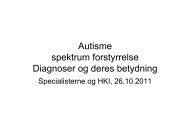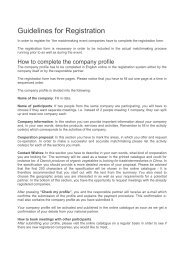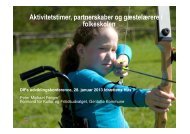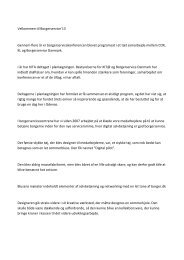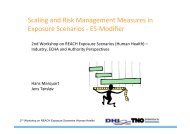Clusters are individuals - VDI/VDE-IT
Clusters are individuals - VDI/VDE-IT
Clusters are individuals - VDI/VDE-IT
Create successful ePaper yourself
Turn your PDF publications into a flip-book with our unique Google optimized e-Paper software.
EXECUTIVE SUMMARY<br />
In economic and innovation policy the term „cluster“ is<br />
usually used to explain geographical concentrations of economic<br />
and innovation activities. According to conventional<br />
wisdom clusters support economic development through<br />
the specialization of regions in activities within which companies<br />
gain higher productivity through accessing external<br />
economies of scale or other comparative advantages. During<br />
the past 15 years clusters and innovative (competence)<br />
networks have gained more and more importance as an element<br />
of economic development and innovation strategies<br />
of the European Union and its Member States. The analyses<br />
in this report challenge conventional wisdom of what drives<br />
development and innovation within a cluster. Based on the<br />
largest international analysis of its kind involving a simultaneous<br />
benchmarking of more than 140 cluster organisations<br />
and of cluster policies from nine European countries it<br />
is found that the economic impacts of clusters depend on<br />
many more factors not related to the specialization of regions<br />
through the geographical concentration of the cluster<br />
than earlier research suggests. Cluster management excellence<br />
and the spectrum and frequency of business-related<br />
services of the cluster organization <strong>are</strong> important determinants<br />
for the impact of a cluster. The analyses of cluster<br />
organisations and cluster policies also show many other key<br />
determinants for the development and characteristics of a<br />
cluster such as internationalization activities, R&D activities,<br />
age, technology <strong>are</strong>as etc.<br />
The Danish Ministry of Science, Technology and Innovation,<br />
supported by the German Federal Ministry of Economics and<br />
Technology and its national cluster program “Initiative Kompetenznetze<br />
Deutschland” (Competence Networks Germany),<br />
the Nordic Council of Ministers and Nordic Innovation<br />
(NICe), has initiated the project „NGPExcellence – Cluster<br />
Excellence in the Nordic Countries, Germany and Poland“.<br />
Further partners were VINNOVA (Sweden), Tillväxtverket<br />
(Sweden), the Finnish Funding Agency for Technology<br />
and Innovation (TEKES), the Finnish Ministry of Employment<br />
and the Economy, Innovation Norway, the Icelandic Centre<br />
for Research (RANNIS), Innovation Centre Iceland, the Bavarian<br />
Ministry of Economic Affairs, Infrastructure, Transport and<br />
Technology (Germany) and the Polish Agency for Enterprise<br />
Development (PARP).<br />
The overall objective is to contribute to the development<br />
of outstanding clusters through excellent management<br />
and excellent cluster programs. Conducted from October<br />
2010 to July 2011the project pays particular attention<br />
on the characteristics of cluster management organizations<br />
and their effects on cluster development. More than 140 cluster<br />
management organizations from eight countries were<br />
benchmarked to base the analysis on a comprehensive comparative<br />
portfolio. 16 cluster programs from nine countries<br />
supporting most of the analyzed cluster organisations were<br />
analyzed to facilitate a better understanding of successful<br />
strategies and mutual learning between the program owners<br />
and to develop recommendations for a “perfect” cluster<br />
program.<br />
The analyses has provided a comprehensive set of information<br />
and new knowledge about the characteristics<br />
of cluster management organizations and clusters in<br />
terms of age, size, composition of membership, regional<br />
concentration and financing. The key findings of the<br />
comprehensive benchmarking analyses of cluster management<br />
organizations include:<br />
• Research-driven clusters <strong>are</strong> much more similar to<br />
industry-clusters than previous research suggested;<br />
• <strong>Clusters</strong> with a small or high sh<strong>are</strong> of public funding <strong>are</strong><br />
similar in terms of structure and governance, but different<br />
in terms of impact;<br />
• The visibility and attractiveness of a cluster and the<br />
impact of the cluster management organization on SME<br />
development depends its age and size; app<strong>are</strong>ntly,<br />
larger and matured clusters provide a much better<br />
environment for results and impacts through activities<br />
of a cluster management organization;<br />
• The structural characteristics of a cluster in terms of e.g.<br />
size, governance structure or degree of specialization<br />
as well as the impact of the work of a cluster management<br />
organization depend on the technology field it is .<br />
operating in;<br />
• <strong>Clusters</strong> with a high impact on business activities of SME<br />
feature an active cluster management organization in<br />
terms of spectrum and frequency of business-related<br />
services.<br />
The results suggest that several key determinants matter in<br />
terms of a cluster’s impact on the business activities of its<br />
members; this applies in particular to SME. Structural factors<br />
such as size, age, governance and the sh<strong>are</strong> of private<br />
funding in the total budget of the cluster management organization<br />
as well as the type of agenda setter (industry or<br />
research stakeholders) have an effect on the spectrum and<br />
intensity of services provided by the cluster management<br />
organization and thus on the development of business activities<br />
of SME.<br />
The benchmarking of 16 cluster programs provides new<br />
knowledge and detailed insights into program characteristics<br />
in terms of objectives, strategic focus, instruments,<br />
target groups, evaluation methods, terms and<br />
financial aspects. The key findings of the analysis <strong>are</strong>:<br />
8




